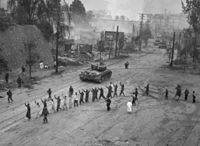The Second Battle of Seoul was the battle to recapture Seoul from the North Koreans in late September 1950.
Approaching Seoul[]

American M26 Pershing tanks in downtown Seoul during the Second Battle of Seoul. In the foreground, United Nations troops round up North Korean prisoners-of-war.
The advance on Seoul was slow and bloody, after the landings at Inchon. The reason was the appearance in the Seoul area of two first-class fighting units of the North Korean People's Army, the 78th Independent Infantry Regiment and 25th Infantry Brigade, about 7,000 troops in all.[3]
The NKPA launched a T-34 attack, which was trapped and destroyed, and a Yak bombing run in Incheon harbor, which did little damage. The NKPA attempted to stall the UN offensive to allow time to reinforce Seoul and withdraw troops from the south.[citation needed] Though warned that the process of taking Seoul would allow remaining NKPA forces in the south to escape, MacArthur felt that he was bound to honor promises given to the South Korean government to retake the capital as soon as possible.[citation needed]
On the second day, vessels carrying the U.S. Army's 7th Infantry Division arrived in Incheon Harbor. General Almond was eager to get the division into position to block a possible enemy movement from the south of Seoul. On the morning of September 18, the division's 2nd Battalion of the 32nd Infantry Regiment landed at Incheon and the remainder of the regiment went ashore later in the day. The next morning, the 2nd Battalion moved up to relieve an U.S. Marine battalion occupying positions on the right flank south of Seoul. Meanwhile, the 7th Division's 31st Infantry Regiment came ashore at Incheon. Responsibility for the zone south of Seoul highway passed to 7th Division at 18:00 on September 19. The 7th Infantry Division then engaged in heavy fighting with North Korean soldiers on the outskirts of Seoul.
Before the battle, North Korea had just one understrength division in the city, with the majority of its forces south of the capital.[4] MacArthur personally oversaw the 1st Marine Regiment as it fought through North Korean positions on the road to Seoul. Control of Operation Chromite was then given to Major General Edward Almond, the X Corps commander. General Almond was in an enormous hurry to capture Seoul by September 25, exactly three months of the North Korean assault across the 38th parallel.[5]
The battle[]
On September 22, the Marines entered Seoul to find it heavily fortified. Casualties mounted as the forces engaged in desperate house-to-house fighting. Anxious to pronounce the conquest of Seoul, Almond declared the city liberated on September 25 despite the fact that Marines were still engaged in house-to-house combat (gunfire and artillery could still be heard in the northern suburbs). After the battle, South Korean Police executed the citizens and their families who were suspected as communist sympathzes. The massacre is known as Goyang Geumjeong Cave Massacre and Namyangju Massacre.[6][7]
See also[]
Notes[]
- ↑ Halberstam The Coldest Winter, p. 302.
- ↑ Hoyt, Edwin P. (1984). On To The Yalu. New York: Stein and Day. p. 98.
- ↑ Hoyt, Edwin P. (1984). On To The Yalu. New York: Stein and Day. p. 98.
- ↑ Baldwin, Hanson W. (September 27, 1950). "Invasion Gamble Pays". p. 6. http://select.nytimes.com/gst/abstract.html?res=F70716FE3A5F11738DDDAE0A94D1405B8089F1D3. Retrieved June 18, 2006.
- ↑ Hoyt, Edwin P. (1984). On To The Yalu. New York: Stein and Day. p. 77.
- ↑ "Goyang Geumjeong Cave Massacre memorial service". Feb.9,2010. http://www.hani.co.kr/arti/english_edition/e_national/403731.html. Retrieved 2011-11-29.
- ↑ Charles J. Hanley and Jae-Soon Chang (Dec. 6, 2008). "Children 'executed' in 1950 South Korean killings". Associated Press. http://www.utsandiego.com/news/2008/dec/06/korea-mass-executions-120608/. Retrieved 2012-09-02.
References[]
- Halberstam, David (2007). The Coldest WInter – America and the Korean War. New York: Hyperion. ISBN 978-1-4013-0052-4.
- Hoyt, Edwin P., On To The Yalu, (1984), ISBN 0-8128-2977-8
The original article can be found at Second Battle of Seoul and the edit history here.
